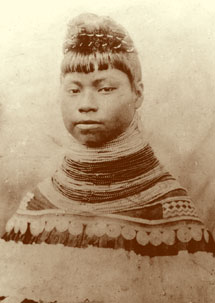 |
Studio photograph of Ruby Tigertail, Charlie Tigertail's sister in
traditional dress wearing multiple strands of beads. Circa 1920.
|
Prehistoric Land & Sea
Southwest Florida has been shaped and reshaped
by centuries of shifting sea action and limestone build-up. During the Ice
Ages, each time the polar ice
sheets reformed
and lowered the surrounding sea level, another layer of sand and shell was
deposited, creating the limestone and sandy sediment that lie beneath much
of Collier County
today. This gradual building process continued until about 25,000 years ago,
when the southern tip of Florida was flooded by tropical seas for the last
time.
The American Serengetti
Rich fossil finds show that this region was once home to camels, mastodons,
mammoths, saber-toothed cats, and huge herds of bison, deer and wild horses.
The animal population reached its peak during the Pleistocene Period about
10,000 years ago, when the number and variety of animals here approached
that of the big game region of the African Serengeti. Gradual changes in
climate,
vegetation and habitat contributed to their extinction.
South Florida’s First People
The first humans reached Southwest Florida at least 10,000 years ago, when
the climate was colder and drier. Living in small, widely scattered bands,
these first Floridians or Paleoindians, survived by hunting and fishing and
by gathering wild plant foods. The descendants of these hardy Paleo hunters
eventually settled into more permanent communities and evolved into one of
Florida’s most distinctive and highly developed Native American civilizations – the
Calusa.
The Calusa Indians
Centuries before Columbus landed in the Americas; Florida’s lower Gulf
coast was controlled by the powerful Calusa Indians. Once numbering as many
as 10,000 people, the Calusa were ruled by a single chief or cacique, supported
nobility and standing army, engineered canals, built huge mounds of shell and
earth for their temples and important buildings, and collected tribute from
a vast empire of towns and villages reaching all the way across south Florida
to the Atlantic. Highly skilled Calusa artists also created elaborate masks
and wooden carvings for religious and ceremonial purposes, such as those discovered
by archaeologist Frank Hamilton Cushing on Marco Island in 1895.
European Arrival
Juan Ponce de Leon discovered and claimed Florida for Spain in 1513 and led
the first recorded European exploration of the Gulf coast. He returned to
colonize Southwest Florida in 1521, but was driven off and mortally wounded
in a battle with Calusa warriors. Other Spanish explorers and adventurers
attempted the conquest of Florida over the next forty years. The expeditions
failed, but decades of warfare, enslavement and epidemics of infectious European
diseases ultimately destroyed the Calusa and their cultural heritage.
The Seminole
By the early 1700s, small bands of Creek Indians from Georgia and Alabama began
making their way into Florida to hunt, farm and herd cattle. Eventually,
these breakaway groups of Indians joined with escaped black slaves and refugees
from other tribes to forge a new identity known as the Seminole. By the time
the United States acquired Florida from Spain in 1821, there were an estimated
5,000 Seminole living in the territory. Ongoing disputes and border skirmishes
with white settlers ultimately led to government pressure to move the Seminole
to reservations west of the Mississippi River.
The Seminole Wars
Between 1817 and 1858, the U.S. Government fought three long, costly and tragic
wars to remove the Seminole from their Florida homes by force. Although vastly
outnumbered, Seminole war parties fought the Army to a stalemate during the
Second Seminole War, making it the bloodiest and most expensive Indian war
in U.S. history. A chain of forts along the fringes of Collier County were
reactivated when a third and final fight with the Seminole broke out in 1855.
The few surviving Seminole found refuge deep in the Everglades and Big Cypress
Swamp where they developed a culture uniquely suited to the climate and terrain
of south Florida.
Life On The Florida Frontier
Southwest Florida remained virtually uninhabited until after the Civil War
when a handful of settlers began drifting south to rebuild their lives on
the raw Florida frontier. The first arrivals were squatters who made their
way down the peninsula during the 1870s and 1880s in mule wagons, ox carts
or sailboats. They settled mostly along the coast, often starting out in
a makeshift palmetto shack. Strongly self-reliant, these early pioneers fished
and hunted for a living, raised crops of cabbage, peppers, tomatoes, sugar
cane and pineapples, dug clams and oysters, made charcoal, sold bird plumes,
and trapped otters and alligators for their pelts and hides. Trading posts
started by Ted Smallwood on Chokoloskee Island and George Storter at Everglade,
became important gathering places for the few isolated settlers and Indians
living on the south Florida frontier. By the late 1880s, Naples and Marco
Island were already gaining popularity as winter resorts for wealthy Northerners
and sportsmen.
The Tropical Range
Cattle ranching are one of Collier County’s oldest industries. Native
Florida scrub cattle were the descendants of cows that had strayed from herds
the Spanish had brought to the New World in the 1500s. During the Civil War,
Florida cow men supplied the Confederacy with cattle and also carried on a
lively cattle trade with Cuba. By the early 1900s, ranchers like Bob Roberts,
Jehu Whidden and Robert Carson were grazing herds of scrub cattle on the open
prairies and grasslands around Immokalee. Railroads improved access to market
in the 1920s and helped raise the County’s beef cattle industry to national
importance by the end of World War II. The term “cracker” is said
to have come from the crack or popping sound made by the cattlemen’s
braided leather whips as they worked their herds.
New Directions
Collier County’s creation in 1923 and its early economic growth were
closely associated with Memphis-born millionaire, Barron Gift Collier. With
his fortune from streetcar advertising, Collier introduced paved roads, electric
power, telegraphs, telephones and countless new businesses and homeowners to
Florida’s last frontier. Railroads and the completion of the Tamiami
Trail in 1928 also began to unlock the region’s enormous agricultural
and resort potential. Florida’s first commercial oil well was drilled
at Sunniland in 1943, and Collier County’s cypress logging industry flourished
at Copeland well into the 1950s.
Only Yesterday
World War II introduced hundreds of servicemen and their families to Naples
and Collier County when the U.S. Army Air Field (now Naples Airport) was activated
in 1943 to train pilots for combat in Europe and the Pacific. At the height
of the war, several hundred men and 75 aircraft were assigned to the Naples
base. Many veterans returned to Southwest Florida after the war as prospective
homebuyers and businessmen. Tourism boomed 200% in 1955 as better rail connections,
air travel and dramatic improvements in the state’s road system gave
seasonal visitors greater access to Collier County. A direct hit by Hurricane
Donna in 1960 caused millions of dollars in property damage, but actually stimulated
Naples’ growth with an infusion of insurance money and low interest loans.
Modern Collier County
In the short span of only fifty years, the number of County residents swelled
from 6,488 in 1950, to an astonishing 251,377 today. The County seat was
transferred from Everglades City to East Naples in 1962, and signaled a new
era of sustained prosperity and growth in agribusiness, tourism, construction
and real estate that have made Collier County one of the fastest developing
areas in the nation. |
